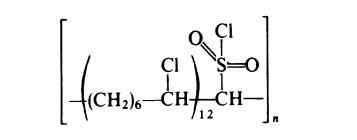| Identification | Back Directory | [Name]
POLY(ETHYLENE) | [CAS]
68037-39-8 | [Synonyms]
CSPE
Ethyleneresinchlorosulfonated
CHLOROSULFONATED POLYETHYLENE
POLY(ETHYLENE), CHLOROSULFONATED
ETHYLENE, CHLOROSULFONATED RESIN
Ethylene resin, chlorosulfonated
Chlorosulfonatedpolyvinylchlorideresin
CHLOROSULFONATED POLYETHYLENE ( HYPOLAN )
ethene,homopolymer,chlorinated,chlorosulfonated
CHLOROSULFONATED CHLORINATED ETHENE HOMOPOLYMER)
Polymer Manual Registration Generic Registration
Poly(ethylene), chlorosulfonated, contains 43% Cl, 1.1% S | [EINECS(EC#)]
202-905-8 | [Molecular Formula]
C2H4 | [MDL Number]
MFCD00084425 |
| Hazard Information | Back Directory | [Chemical Properties]
light yellow waxy solid | [Uses]
rubber hose;electric wire and cable;special synthetic rubber;wires and cables | [Preparation]
In the preparation of chlorosulphonated polyethylene the polymer (commonly, a low density polyethylene with molecular weight (Mn) of about
20000) is treated with chlorine in the presence of a small amount of sulphur
dioxide. Typically, the reaction is carried out in solution in hot carbon
tetrachloride. Both chloride and sulphonyl chloride groups are introduced
into the polymer, the degree of substitution and the ratio of the two types of
groups depending on the reaction conditions. Commercial products generally
contain about 30% chlorine and 1.5% sulphur, which corresponds to
approximately one chlorine group per 7 carbon atoms and one sulphonyl chloride group per 85 carbon atoms. Such a product may be represented as
follows:

The reaction probably proceeds by the following radical mechanism:

| [Production Methods]
This type of elastomer is made by dissolving polyethylene in
carbon tetrachloride and then treating it with chlorine and
sulfonyl chloride in the presence of a catalyst. After the
desired degree of chlorosulfonation has been attained, the
residual chlorine–sulfur dioxide mixture is stripped off, a
stabilizer is added, and the commercial product is isolated as
raw rubber in crumb or film form. | [Industrial uses]
This material, more commonly known as Hypalon,can be compounded to have an excellentcombination of properties including virtuallytotal resistance to ozone and excellent resistanceto abrasion, weather, heat, flame, oxidizingchemicals, and crack growth. In addition,the material has low moisture absorption, gooddielectric properties, and can be made in a widerange of colors because it does not require carbonblack for reinforcement. Resistance to oilis similar to that of neoprene. Low-temperatureflexibility is fair at –40°C.
The material is made by reacting polyethylenewith chlorine and SO2 to yield chlorosulfonatedpolyethylene. The reaction changes thethermoplastic polyethylene into a synthetic elastomerthat can be compounded and vulcanized.The basic polyethylene contributes chemicalinertness, resistance to damage by moisture, andgood dielectric strength. Inclusion of chlorinein the polymer increases its resistance to flame(makes it self-extinguishing) and contributes toits oil and weather resistance. | [Solubility in organics]
MEK, THF, toluene |
|
|